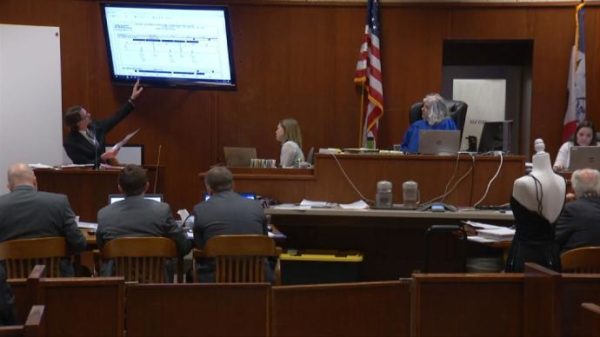
DAVENPORT, Iowa (KCRG) – Monday served as the starting point for the second week of the murder trial for 66-year-old Jerry Burns, who stands accused of first-degree murder in the death of then 18-year-old Michelle Martinko in December 1979.

Michael Schmit, left, testifies during the first-degree murder trial of Jerry Burns on Monday, Feb. 17, 2020, at the Scott County Courthouse in Davenport. Burns is accused in the death of then 18-year-old Michelle Martinko in December 1979. (Pool Photo)
Prosecutors called two witnesses that received most of the attention during the day: Investigator Matthew Denlinger with the Cedar Rapids Police Department, and criminalist Michael Schmit with the Iowa Division of Criminal Investigations crime lab.
In the week prior to Monday, much of the discussion in court was related to how evidence was handled over the decades since the crime, with the defense questioning whether or not it was contaminated or handled properly. Denlinger testified that protocol was followed to the best of their ability, and even if there was a disconnect between officers, it would not have affected the results of the case.
Denlinger has been in the courtroom since the first day of jury selection, sitting with the prosecution team. He took the stand Monday as a witness in the case, something he was already familiar with after an evidence suppression hearing in January.
Denlinger explained the police department’s relationship with Parabon, a company that specializes in DNA technology and testing. Parabon was instrumental in 2017, creating renderings of a possible suspect using a DNA sample collected from the 1979 scene.
“‘Snapshot’ was the forensic DNA analysis service that attempted to predict physical appearance in Ancestry of an unknown person from their DNA. This is known as DNA phenotyping,” Denlinger read.
From the time investigators began working with Parabon, Denlinger explained how investigators were given leads to an extensive family tree that helped them narrow their search.
“It explained that if I was able to collect DNA from a living relative on each branch of that tree and send those swabs back to them, then they could tell me which branch of the family tree our suspect was on,” Denlinger said.
The family tree ultimately led investigators to Burns and his two brothers, after a DNA sample was given by one of Burns’ cousins.
The defense has questioned how evidence was handled, and whether or not that could taint the evidence. During the 2008 flooding in Cedar Rapids, water pooled inside the evidence room resulting in some evidence bags being saturated, including the bag that had Martinko’s dress.
While those bags were put through a recovery process, Burns’ attorney, Leon Spies, argues the evidence was left unattended after the package came back. He used that to allege improper handling of key evidence.
Denlinger argues the point that the defense is making does not matter because they already had the information they needed. The DNA was already acquired off Martinko’s dress and they already had a profile for their lead suspect.
“At that point, we had already found the useful information on it,” Denlinger said. “DNA Labs had already explained to me we’re not going to find more DNA on it. It went through the flood, there was humidity, that’s the reason we stopped testing when we did.”
Denlinger is expected to return to the witness stand later on during the trial.
The prosecution called Schmit in the afternoon, who has 22 years of experience in his department at the Iowa DCI. He explained the process in matching Burns to the crime scene using DNA acquired from a straw that police retrieved at a Pizza Ranch in Manchester.
“When it came to this straw, I was making matches in each of the loci that we had results for,” Schmit said. “[It was] just kind of unbelievable that the type of technology to get us to this point existed. It seemed kind of science fiction to me.”
Loosely defined, loci make up part of a person’s DNA.
Schmit explained when they matched the DNA from Martinko’s dress to the DNA of Burns, it was a clearer match than one he had seen in his time with DCI. This led them to believe that the odds of finding a similar match at random would be one in 100 billion.
“A match of 12 loci, I would only expect to come from an identical twin of Jerry Burns,” Schmit said. “In my 22 years of working forensic DNA cases, I’ve seen matches between family members with 7 or 8 loci, but I’ve yet to see one with 12-13 loci.”
The trial will resume Tuesday, Feb. 18, at the Scott County Courthouse at 9:00 a.m.














